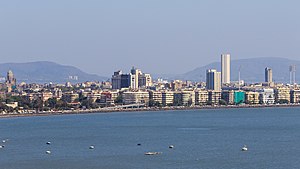Economy of Mumbai
This article needs additional citations for verification. (March 2009) |



Mumbai, Maharashtra is the entertainment, fashion and commercial centre of India having nominal GDP of $278 Billion (till Oct 15 from 2014).[1] It is also one of the world's top 10 centres of commerce in terms of global financial flow,[2] Mumbai accounts for slightly more than 6.16% of India's economy contributing 10% of factory employment, 30% of income tax collections, 60% of customs duty collections, 20% of central excise tax collections, 40% of foreign trade and rupees 40,000 crore (US $10 billion) in corporate taxes to the Indian economy.[3] Headquarters of a number of Indian financial institutions such as the Bombay Stock Exchange, Reserve Bank of India, National Stock Exchange, the Mint, as well as numerous Indian companies such as the Tata Group, Essel Group and Reliance Industries are located in Mumbai. Most of these offices are located in downtown South Mumbai which is the nerve centre of the Indian economy. Many foreign establishments also have their branches in the South Bombay area. Mumbai is the world's 29th largest city by GDP.[4] Mumbai was ranked among the fastest cities in India for business startup in 2009.[5] As of 2009-10, Mumbai enjoys a Per Capita Income of $2,845. This is 16.6% higher than 2008-09 levels of $2,440. In PPP dollars, Mumbai had a Per Capita Income of $7,050 as of 2009-10 fiscal. In the recent years Mumbai is experiencing rapid growth. By 2020-21 fiscal, Mumbai's GDP Per capita at PPP is expected to reach US$23,000, making it South Asia's richest city [6]
Occupations
Mumbai has traditionally owed its prosperity largely to its textile mills and its seaport till the 1980s. These are now increasingly being replaced by industries employing more skilled labour such as engineering, diamond polishing, healthcare and information technology. Mumbai is also the primary financial centre for India, both the major Indian stock exchanges (BSE and The National Stock Exchange), brokerages, asset management companies (including majority of the mutual fund companies), headquarters of most Indian state-owned and commercial banks, as well as the financial & monetary regulatory authorities of India (SEBI and RBI among other institutions).
As Mumbai is the capital of Maharashtra, government employees make up a large percentage of the city's workforce. Mumbai also has a large unskilled and semi-skilled labour population, who primarily earn their livelihood as hawkers, taxi drivers, mechanics and other such proletarian professions. The port and shipping industry too employs many residents directly and indirectly. Like most metropolitan cities, Mumbai also has a large influx of people from rural areas looking for employment.
The entertainment industry is the other major employer in Mumbai. Most of India's television and satellite networks are located in Mumbai, as well as the major publishing houses. A large number of the Hindi and English television shows are produced in Mumbai. The Hindi movie industry, known by some as Bollywood, is also located in Mumbai, along with the largest studios and production houses. To add to this, most major advertising companies operating in India also have their primary office in Mumbai.
Industries
Several major Indian companies are headquartered in Mumbai. The three largest private companies in India, Reliance Industries, Tata Group and Aditya Birla Group, are based in Mumbai. Below is a list of some of these major companies:
| Company | Revenue (billion US$) |
|---|---|
| Tata Group | 100.0 |
| Reliance Industries | 73.1 |
| Aditya Birla Group | 40.0 |
| Hindustan Petroleum | 34.44 |
| Bharat Petroleum | 39.45 |
| State Bank of India | 36.95 |
| Reserve Bank of India | 311.86 |
| ICICI Bank | 13.52 |
| Larsen & Toubro | 14.0 |
| Reliance ADAG | 15.4 |
| Essar Group | 39.0 |
| HDFC Bank | 6.48 |
| Axis Bank | 4.42 |
| Bank of Baroda | 5.51 |
| Bank of India | 5.44 |
| IDBI Bank | 4.61 |
| Union Bank of India | 4.12 |
| Hindalco Industries | 14.0 |
| Bajaj Group | 6.69 |
| Godrej Group | 3.7 |
| Mahindra Group | 15.9 |
| JSW Group | 7 |
| RPG Group | 4.01 |
Consumer Goods Industries
Mumbai is home to some of India's largest consumer packaged goods companies like Hindustan Unilever,[7] Procter & Gamble,[8] Nivea,[9] Colgate-Palmolive,[10] Godrej Consumer Products [11] and many more.
Other


One of the more unusual features of the Mumbai economy is the Dabbawala system that allows hot, frequently home-cooked, food to be delivered to office workers at their place of work with remarkable efficiency.
Below is a list of major industries located in Mumbai:
- Hindi film industry
- Automotive parts
- Utensils
- Biscuits (Cookies)
- Clothing
- Textile mills
- Pencils
- Tractors
- Pharmaceuticals
- Import
- Export
- IT
- Health Care
See also
References
- ^ http://www.defencenews.in/article/India-adds-one-Pakistan-to-its-GDP-Year-On-Year--305
- ^ "Mumbai, a land of opportunities". The Times Of India. 20 July 2011.
- ^ Mumbai, Mumbai city, Mumbai tourism, Mumbai tour, Maharashtra Capital Mumbai, Commercial Capital Mumbai, Bollywood Mumbai, Mumbai Transport
- ^ The 150 richest cities in the world by GDP in 2005, dated 11 March 2007. The list fails to include Taipei. Accessed 3 July 2007.
- ^ "Doing Business in India 2009". World Bank. Retrieved 2010-06-08.
- ^ http://www.supportbiz.com/articles/vertical-view/mumbai-land-opportunities-wants-govt-support.html
- ^ http://www.hul.co.in/resource/contact/default.aspx
- ^ http://www.pg.com/en_IN/company/contact-us.shtml
- ^ http://www.nivea.in/
- ^ http://www.colgate.co.in/app/Colgate/IN/Corp/Investor/RegdOffice.cvsp
- ^ http://www.godrejcp.com/contact-us.aspx
